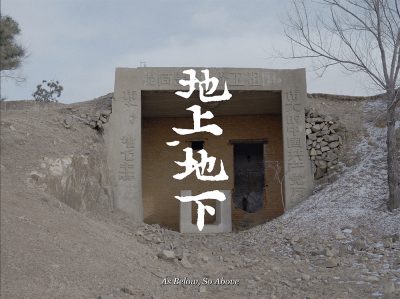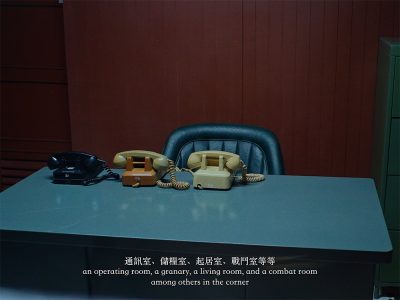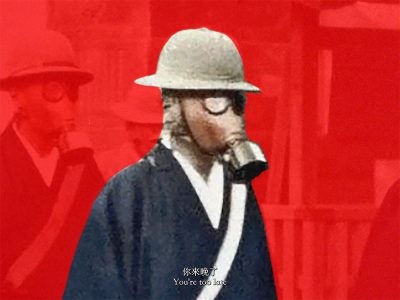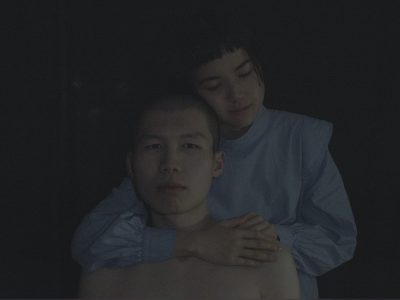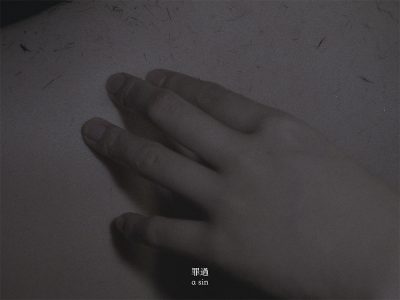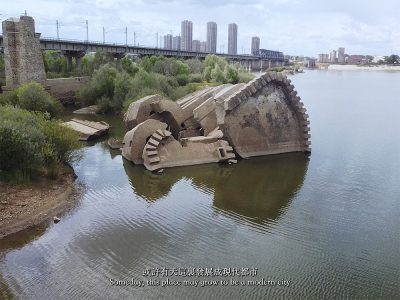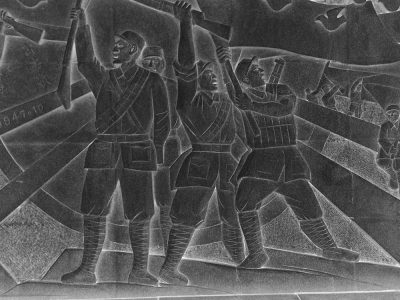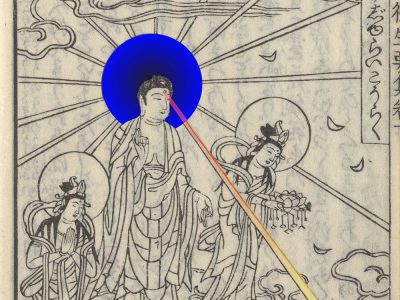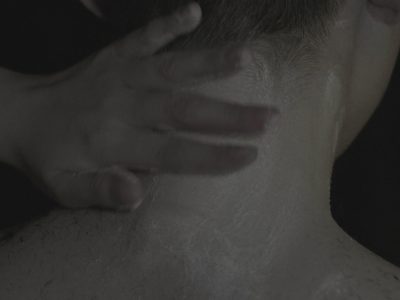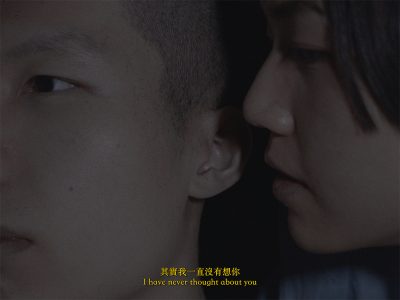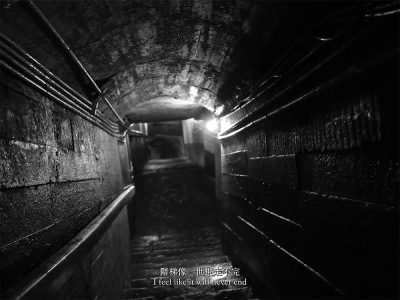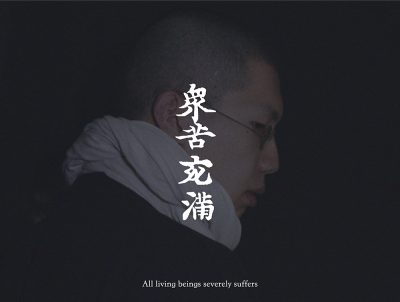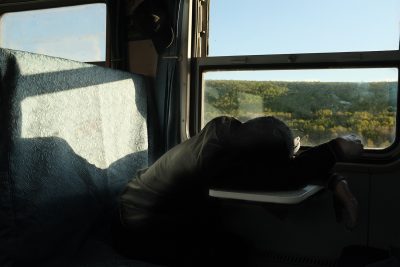As Below, So Above (2023)
Single-channel video installation
4:3 | 4K | Colour | 32’27” | Stereo | Japanese dialogue | Chinese and English subtitles
By the end of WWII, a surviving logistic soldier and a Buddhist Jodo Shinshu Hongwanji sect military missionary still stayed in the Hailar underground fortress, which was a frontline military fortress situated near the Manchuria and Soviet Union border. The fortress covered 21 square kilometres through the mountains and the city, which had been unnoticed even by those living above ground. To kill time in the underworld, the soldier and monk had casual conversations that covered everything from a Buddhist scripture banned by their motherland to the question of whether the Soviet red army had already left.
The underground fortress was a maze; those who were living in the dark learnt to endure the spectres, otherwise, the deadly air would consume the beings’ souls. The fortress was deafeningly silent, only the sound of blowing wind from the exit of the underground fortress could be heard. The soldier peered out a hole at the tunnel ceiling, which was blown open by the Soviets, and he spots no sign of human beings.
After being physically confined for a long time, people lost immunity to that invisible, pervasive, and airborne fear. Instead of embracing the long-desired freedom, the sudden release caused mental disorientation and discomfort, which were more virulent and contagious than the virus, and seep permeably into our minds and fleshes. As the classic hermeticism suggests, As Above, So Below: that which is above is from that which is below, the underground darkness could not train a slight feeling of tranquillity, just as the illness of ignorance above ground blinds the eyes.
The military missionary sat crouched at the entrance of the tunnel, inaudibly chanting the forbidden verse.
The project is commissioned by Asia Culture Center (Gwangju, South Korea).
Reference
Books
Hasegawa, Sadanobu I (長谷川貞信) and Yokokawa, Shūtō (橫河秋濤). The Door to Civilisation (開化乃入口). Ōsaka: Matsumura Kuhei (大阪:松村九兵衛). 1874.
Ives, Christopher. Imperial-Way Zen: Ichikawa Hakugen’s Critique and Lingering Questions for Buddhist Ethics. University of Hawai’i Press, 2009.
Jerryson, Michael K., and Mark Juergensmeyer, eds. Buddhist Warfare. Oxford ; New York: Oxford University Press, 2010.
Matsuyama, Fumio (松山文生). War of Haliar, Manchuria (満州ハイラル戦記), self-publishing. 1994.
Rhodes, Robert. Genshin’s Ōjōyōshū and the Construction of Pure Land Discourse in Heian Japan. University of Hawai’i Press, 2017.
Victoria, Brian Daizen. Zen at War. Rowman & Littlefield Publishers, 2006.
Victoria, Brian Daizen. Zen War Stories. Taylor & Francis, 2012.
Tanaka, Nagane (田中長嶺). ‘The Smelting of Temple Bells.’ Pictorial history of Martyrdom in the Meij Era (明治殉教絵史). Tokyo: Seikado, 1907.
Records
《緊急地下建設部隊ノ編成及運用ニ関スル件ヲ定》, 1944, 類02866100, 公文類聚・第六十八編・昭和十九年・第六十八巻・軍事二・防空・徴発, National Archives of Japan (國立公文書館). https://www.digital.archives.go.jp/file/1657124.html. Accessed April 7, 2023.
Journal article
Itani, Kotaro (稲田光太郎). ‘For the Study of Buddhist Military Chaplains of the Empire of Japan: The Life and the Annotated Bibliography of Rev. Gan-Ei SATO, a Member of the 9th Division in the Russo-Japanese War (帝国日本の従軍僧研究に向けて : 日露戦争第9師団従軍布教使佐藤巌英の生涯と著作).’《日本学報》, vol. 35, p.189-199. Institute of Japanese Studies, Graduate School of Letters, Osaka University (大阪大学大学院文学研究科日本学研究室), 2016.
Nose, Eisui (野世英水). ‘The War Missionaries of the Modern Nishi Honganji Tradition (近代真宗本願寺派の従軍布教活動).’ Indian Buddhism Research Journal (印度學佛教學研究), vol. 63, p. 26-31. Tokyo: The Japanese Association of Indian and Buddhist Studies, 2014.
Shields, James Mark. ‘A Blueprint for Buddhist Revolution: The Radical Buddhism of Seno’o Girō (1889–1961) and the Youth League for Revitalizing Buddhism.’ Japanese Journal of Religious Studies 39, no. 2 (2012): 333–51. http://www.jstor.org/stable/23343743. Accessed April 07, 2023.
Book published electronically
Genshin (源信). Ōjō yōshū shō (往生要集鈔) Maki 4, 984. Bukkyo University Library Digital Collection (佛教大学図書館デジタルコレクション). https://bird.bukkyo-u.ac.jp/collections/ojoyoshu-04/. Accessed Janurary 10, 2023.
Photographs
Anonymous. Monks in a bombing drill, Senso Temple, Asakusaa, Tokyo, Japan, 1936. https://ww2db.com/image.php?image_id=25221. Accessed April 7, 2023.
Anonymous. Sankei Digital Inc., ed. ‘No blindspot in Haliar Fortress’ (ハイラル要塞に死角なし).’ Sankei News (産経新聞), August 22, 2022. https://www.sankei.com/article/20220822-FBHQ5SPWVJO4HAAWXFM4VLQWTI/photo/G36GN2IWINLDLGRSYZC6PIAZJI/. Accessed April 7, 2023.
Artwork
TANAKA, Nagane (田中長嶺). Burning of Sutras and Religious Implements. Woodblock print. 1907.
TSE Tsan-tai (謝纘泰). The Situation in the Far East (時局圖), 1899.
Keppler, Udo J. The Real Trouble will Come with the ‘Wake’, 1900. The Library Congress, USA.
